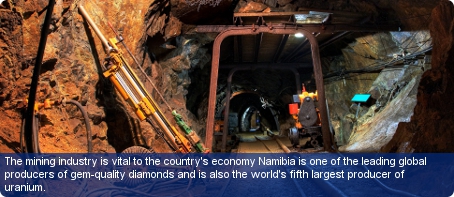Find a business in Namibia

The south-west African state of Namibia joined the Commonwealth in 1990 after gaining independence and has seen relatively strong growth since then. Its economy is driven by mining – the largest source of export earnings – and fish processing. It has a strong GNI per capita of US$5,610 (2012) and has seen GDP growth of 3.8% per annum (2008-12). Diversification into manufacturing activities, such as clothing and textiles, has been encouraged but growth has been concentrated in the urban areas.
Manufacturing contributes to 12% of Namibia’s GDP. The main manufacturing activities are light industry-based and directly link with the country’s agricultural sector. Fish processing is a fast developing sector in terms of employment growth and income. The fish industry as a whole is six times the size of what it was at independence in 1990. Behind agriculture and mining, the fisheries sector is the third-largest in Namibia’s economy. Hake, horse mackerel, pilchards and monkfish are the major catches, a substantial portion of which is destined for the export markets, in particular the EU.
Agriculture together with hunting, forestry and fisheries contribute to 10% of Namibia’s GDP (2010). Livestock ranching is a major commercial farming activity. Agricultural activities, commercial and communal, also include the farming of sorghum, peanuts and grapes. The EU, with which Namibia enjoys a reciprocal trade relationship under an Economic Partnership Agreement, is the major export destination of agricultural produce, mainly meat and grapes.
Namibia is one of the leading global producers of gem-quality diamonds and is also the world’s fifth largest producer of uranium. The economy is heavily dependent on the extraction and processing of minerals for export. Mining accounts for 8% of GDP, but provides more than 50% of foreign exchange earnings. In addition, the country produces large quantities of lead, silver, zinc, tin and tungsten making it the fourth largest exporter of non-fuel minerals in Africa. Exports account for almost 50% of Namibia’s GDP, and of this, diamonds make up 40%. Despite this the mining sector only employs 3% of Namibia’s workforce.
Namibia has 62.29 billion cubic metres of proven natural gas reserves (January 2011 estimate). Mining has also contributed socio-economically by being the major private sector employer. Namibia is widely understood to have a substantial untapped oil and gas potential. A host of companies from around the world have been working hard in the country, onshore and offshore, to uncover what could be the largest oil deposit in the region.
Although there has been substantial growth since 1990, most people in rural areas of this vast country remain largely unaffected by mining and other industrial activity with a large proportion of the population reliant on subsistence farming to live. The economy of Namibia is closely linked to that of neighbouring South Africa and its currency, the Namibian dollar, is linked on a one-to-one basis with the South African Rand.
Namibia is ranked 78th in the world for ease of doing business, according to the World Bank’s ‘Doing Business 2012’ study. But it is placed fourth best in the Sub-Saharan Africa region for dealing with construction permits and enforcing contracts. These rankings measure the conduciveness of a regulatory regime in starting and operating a business.
Namibia has an 76.5% adult literacy rate (2007). English is the official language and used widely, while Afrikaans and German, although used to a lesser extent, are key business languages. Prior to independence in 1990, Afrikaans and German shared equal status as official languages.




